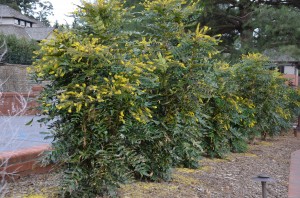Leatherleaf mahonia (Mahonia bealei), aka Beale’s barberry, is a holly-like evergreen shrub which appears in your garden uninvited. It is a member of the barberry family (Berberidaceae) (USDA hardiness zones 6-9). It has no sharp thorns on the stems, but leaf tips are sharply pointed.
Leatherleaf mahonia is a princely evergreen shrub which blooms in late winter, some years earlier. Clusters of sulfur yellow flowers open above the foliage in terminal racemes starting in late February over a 3-4 weeks period. Lush blue green foliage emerges rapidly after flowering. By late summer the mature leaves feel leathery to the touch.
Leatherleaf mahonia prefers a moist, organically rich, well-drained, acidic soil. It is best planted in partial sun to full shade. Spring’s blue-green foliage often turns pale yellow and leaf margins burn following a dry summer.
This native of China often re-seeds prolifically and has earned an invasive reputation in the South. Grape-like clusters of green fruits adorn this plant from April to July. Fruits ripen to a rich powdery blue color, and birds disperse the seeds around the neighborhood.
Leatherleaf mahonia grows 5 to 6 feet in height. It grows mostly vase shape form, 4-5 feet wide of foliage on top and an open narrow base. Utilize leatherleaf mahonia either alone as a specimen or grouped several as a low hedge, privacy screen, or mound.
Leatherleaf mahonia has no serious disease or pest problems. In my opinion, every 4-5 years, cut this shrub back to the ground immediately after flowering to re-invigorate the planting. Otherwise, it often becomes too crowded in its space. The spine-tipped leaves can be devilish to prune and body protection is advised.


 Posted in
Posted in 
